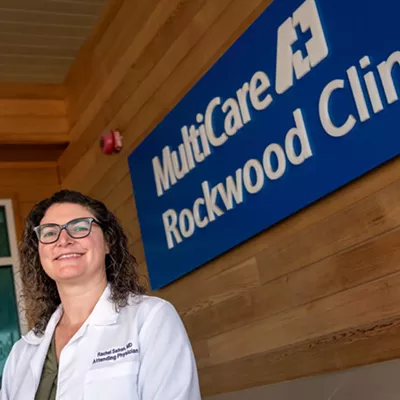
When Josephine Johnson had trouble with pain in her abdomen a short time ago, she went to her doctor in Davenport, where primary care is just a few steps away from Lincoln Hospital.
They did a CAT scan and then a colonoscopy, which she was due for, and discovered cancer. Within a short time, she'd had surgery, and just a few short days later, was on the mend.
"We came in for one thing and came out with another," she says while lying in a hospital bed in the acute care wing of the hospital in late September. "Well, if you don't check, you don't know."
Five days after her surgery, with personally monitored pain management, she was about ready to go home. Being able to receive that care in her community of about 1,700 people meant a lot during what can be a scary time.
"It's fearful enough for so many things that you might have, but when they can help you like this, it's wonderful," she says.
If it weren't for hospitals in small Eastern Washington communities like Davenport, Dayton and Odessa, the nearest emergency room or hospital bed would be another half-hour drive or more for thousands of people like Johnson who live in rural areas.
But since 2010, at least 80 rural hospitals around the country have closed after not being able to make things work financially. Many more are on rocky financial footing.
"When people have accidents, they have this expectation with the 911 system there's a hospital nearby," says Shane McGuire, CEO of Columbia County Health System, which runs the hospital in Dayton, about an hour east of the Tri-Cities. "I'm fearful that we're close to that not being a reality."
Hospitals like McGuire's are known as Critical Access Hospitals. They provide 25 or fewer inpatient beds, and are at least 35 miles from the nearest hospital. Some are managed and partly funded by taxpayers through a public health district, but while their residents' support helps, elements of these smaller health care systems aren't financially sustainable as they run now.
Washington's rural hospitals are slightly better off after the state accepted the Medicaid expansion as part of the Affordable Care Act, allowing more people who otherwise would be uninsured to get covered. However, the rates paid out to hospitals still don't keep pace with costs, McGuire and other hospital administrators say.
"For every dollar I spend to care for patients or residents, I get 98 cents back, so I'm already losing money on every dollar invested in the care," McGuire says. "It's an uphill battle."
So Washington lawmakers agreed to see if they could change the future for rural hospitals by creating the Washington Rural Health Access Preservation project (known as WRHAP; pronounced "wrap"), which will test if a different way of making Medicaid payments can help stop the hemorrhaging of small hospitals' budgets.
'TIME IS HEART'
The WRHAP pilot project was started to get ahead of the problems that rural hospitals are having nationally. Not all hospitals will participate — Davenport is not part of the pilot — but a core group of 14 struggling facilities are in the initial project.
"We don't want to be talking about how Dayton and Odessa lost their hospital, and how do we respond to that," says Jacqueline Barton True, director of rural health programs for the Washington State Hospital Association, which is partnering with the state Department of Health and Healthier Washington, a program of the Washington State Health Care Authority, to run the rural pilot program.
One of the first questions that comes up when talking about rural health care is if those hospital systems aren't making financial sense, why not close them?
First and foremost, administrators point out that proximity to help matters a lot for a patient's outcome, especially when it comes to emergencies like heart attacks and strokes. Common sayings among medical providers are "time is heart" and "time is brain."
Were the hospital at Dayton to close, the nearby ski hill Bluewood would be an hour-and-a-half ambulance away from help, one way, McGuire says. Life Flight may be an option but only when the weather cooperates, he says.
It also turns out that part of what's putting hospitals like Dayton's at risk has less to do with the expensive emergency department than once thought. State officials and politicians often point to empty inpatient beds that see only a small number of patients as the factor causing rural hospitals around the country to have money troubles, says Harold Miller, an expert on health care reform who is helping lead the rural pilot program. Miller is the president and CEO of the Center for Healthcare Quality and Payment Reform, a national policy center that puts out informational reports meant to help everyone from the government to hospital associations.
And while it's true that there are set costs to run an emergency department, and fewer patients means less income to cover those costs, the real issue for many rural health districts is actually the loss at their primary care clinics.
"For most, it was their clinics that were losing the money," Miller says. "Medicaid was one of the biggest underpayers for that."
Data compiled for Washington's rural pilot program show that the biggest loss comes from the primary care clinics that most of the participating hospitals provide, accounting for more than 30 percent of the deficit for most of them.
With Medicaid, rural clinics are eventually paid for every patient they see, but it's through a complicated, multi-step process that can take more than a year to fully reimburse them for the cost of care.
To fix that, the pilot program will allow the state to pay for services under a different logic than currently used.
CHECK'S IN THE MAIL
"We are fortunate in this state to have hospital leaders and partners at the state level who have been very forward-thinking, and willing to embrace new ideas and think about some fundamental shifts we could potentially make in the system, rather than wait and hope the same old thing keeps working," Barton True says.
Rather than pay the hospitals a big bill every time a Medicaid patient comes to the ER, the program will test paying the hospitals a set monthly amount for every Medicaid patient in that hospital's district. If and when someone comes in to use the facility, a much smaller rate than what insurers pay currently would be charged.
A similar model may be applied to primary care clinics, where patients would enroll and pay a regular fee, then not pay when they come in, unless they get some specialized services.
Focusing on changing payments across the board becomes important, Miller says, because if making primary care better — and hopefully keeping people healthier — hurts the number of emergency room or hospital visits, it can create a shortfall there.
"What we kind of discovered through all this was this incredible interconnection between all the services, and it's a domino effect," Miller says. "You can't just fix one thing. Everything has a cascading effect on other things."
While making regular payments whether you use the hospital or not may seem illogical at first, Miller says, it's easy to make a comparison to other services.
"The benefit is having [the hospital] there, but we pay on a per-visit basis," he says of the way things work now. "It'd be equivalent to paying your fire department based on the number of fires they have."
Hospitals are a service that people want around when needed, so paying for them regularly, even if you aren't using them at that moment, makes sense for the community, and will help the hospitals more reliably plan their budgets, he says.
For people who visit the hospital and don't live in the district, you could charge more, Miller explains.
The pilot program will be done first with Medicaid, partly because the state doles out that funding, and because Medicare and Medicaid patients make up a large percentage of the people who go to rural hospitals and clinics for treatment, unlike in more urban areas, where more businesses are likely to offer private insurance.
"Urban markets have a much higher percentage of people who are privately insured. That really matters, because there is a cost shifting that occurs: You make up what you lose with private payers," Barton True says. "If you don't have a private base, you don't have the ability to do that."
That said, Miller says the model could eventually be scaled and applied to all insurance providers. Keeping rural hospitals open is good for insurers, too, he says. It saves them expensive transportation costs if people would otherwise have to be flown or driven to treatment farther away, and saves on unnecessary treatment costs down the line because outcomes are better the sooner someone gets help.
The payment fixes could also be applied to larger hospitals, he says.
"These hospitals need this help maybe more severely than others do, but the kinds of things we're talking about putting in place here are not some special fixes, only for desperate rural hospitals," Miller says. "They actually would apply a lot to other hospitals." ♦





















